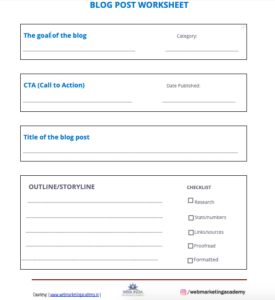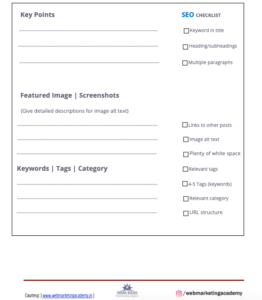💥 A Detailed Step-by-Step #Blogging Guide including #Templates, Worksheets, and Checklists 💥
A Blogging Guide, Template, Worksheet & Checklist

Download the Beginners Guide to Blogging PDF 2020 Edition: A Beginners Guide to Blogging: How to Write your First Blog Post?
Blog was the Word of the Year 2004, Blog or Weblog has been around since 2000. It’s 2020 now and for twenty years Blogging has evolved. When I teach my students I tell them Blogging can help them achieve what they want to become. Apart from that Blogging can:
- Help build trust
- Make you an author
- Help educate the customer in the buying cycle. When they research they are looking for answers, your blog could be their answers
- Help get more traffic and conversion
- Keep our brains active
- Be a therapy
- Help be creative
- Help cultivate a habit
Most of my students have some of these common questions and fears, to help them overcome this fear, I have come up with this detailed step-by-step blogging guide and template
- What if my blog is not good enough?
- I am scared to start. What if I am judged by my writing?
- I don’t know where to start and how to go with the flow while blogging.
- My grammar is not very good
- There is a lot of competition out there
It also includes examples from a well-known writer – Prasant Naidu
This includes everything you need to know about how to write your very first blog post.
Mental Roadblocks before writing a blog
- What if my blog is not as good. Now people know me on social media. What will they think?
No one is perfect, we all make mistakes and in today’s world, it is ok to make mistakes and learn from mistakes. When you embrace authenticity and be real, you will not have to worry about what people will think about your writing.
- I don’t want people to judge me for my writings
You are sharing and helping others by putting out content. Write for that one person whom you want to help. Ignore the rest. When you embrace authenticity and be real, you will not have to worry about what people will think about your writing. - Scared to start. I don’t know where to start? Not clear how to go about the flow
That’s one of the reasons, I am coming up with this template. Use this as a starter kit and reference. It always helps to write about things you are passionate about / care about. This way your blog will always reflect the sincerity and the feelings behind the writing. - A lot of competition out there. Will my blog be lost?
Sure, there is a lot of competition, blogging is all about sharing your opinion and your story/experience. Your story and experiences will always be unique to you and will bring life to your writing - It’s difficult to get the mood to write
Absolutely, you are not alone. We all have the same problem, it’s just like going to the gym, it’s just the starting trouble, once you start to write, it will be easier. Think about the benefits and your blog is going to help a lot of people out there. - My grammar is bad. Will I share the right message? Will others accept it?
The list of procrastination can go on and on. Instead of thinking about everything that may not work, just get started. You have nothing to lose. Use this simple guide and template so you will be safe.
YOUR FIRST BLOG POST WORKSHEET


STEP BY STEP PROCESS & BEST PRACTICES WORKSHEET
A detailed step-by-step blogging template. Use this worksheet as a reference. Every step involves you practice doing it. By the end of this worksheet, you should be able to come up with one blog post by following these best practices. I will be working along with you and I am sharing my own example in all steps
Step 1: Identify your goals
What is the objective and goals of this blog post? Why you want to write this blog post.
Examples:
- I want to share my passion
- I want to be known for _________ online
- I want to build my personal brand
- I want to help the community
- I want to build brand awareness
TIP: Don’t try to market your product or service. You have your website for that
Action Time: List your goal specifically for this blog post
My action: My goal is to educate newbies who want to know the scope of digital marketing
———————————————————————————————————————————-
“Every Google search is a problem, your blog should solve it” – Suresh Babu
Step 2: What to write?
Write something you are passionate about or something you know about.
Research for topic ideas: Use any of the following tools
- Google suggests: Do a Google search for (Topic + A – Z) slowly type in topic A, topic b
- Google suggests: Do a Google search for (Topic + What, when where, why, how)
- Answer the public: www.answerthepublic.com
Action Time: Come up with a topic related to your industry or passion
TIP: Stick to one topic per blog post.
My topic: Scope of Digital Marketing, Digital Marketing Careers in 2020, Digital marketing career path. What is your topic? List your topics here. This is a step-by-step walkthrough. Please do it with me
———————————————————————————————————————————-
Step 3: How to come up with the title for your blog?
This is one of the most important steps. This is what makes a user read. There are two options to come up with your blog title. One start with the title, OR two, you can complete the entire blog post and come up with the title according to what you are writing. Either way, keep SEO in mind.
Your blog title is also important for readers and Google. Be specific
Action Time: Come up with a topic. Be as specific as possible
TIP: This will be your blog title. Every search is a problem. You are solving & optimizing
My topic: “ What is the scope of Digital Marketing in India and How to Get Started”. What is your title? List your title here. This is a step-by-step walkthrough. Please do it with me
———————————————————————————————————————————-
Step 4: Different types of a blog post title
There are several types of blog post titles, depending upon what is message you want to convey. If you are writing about ‘How to’s….., then the reader might expect you to show them how to do
Step by step process
- How to do…….. How Not to do……….
- Case study: How I got 50 K followers on Tik Tok in 10 days
- Top 10 digital marketing courses for engineers
- Personal story: How I transformed from a Chef to a CEO
- What I learned from the last 10 years of teaching
- According to Google, here is what you should do to get into Google
- What they don’t teach in MBA
- 5 Digital Marketing techniques every marketer should know
- Top secrets about Digital Marketing Career
Action Time: Time to get some inspiration. Let’s look into some popular posts on Medium
TIP: Medium.com is a great place for ideas. Sign up, follow me and see whom I am following
My profile on Medium.com: https://medium.com/@sureshbabu_
Make a list of possible titles from popular writers on medium. My recommendations
Step 5: Featured Image for your blog post
This will be the first thing that the readers will see. Get a good relevant picture for your blog post. You can find the relevant image for your blog post from –
- Canva.com
- Picmonkey.com
- Unsplash.com
- Adobe Spark Post app
Action Time: Create your featured image using canva.com
TIP: Use your own pictures, canva has got so many options to add layers, colors, text. I have used a simple screenshot for my blog post showing the trend for digital marketing
———————————————————————————————————————————-
Step 6: Your first paragraph
Your first paragraph is as important as the Title. Here you can either start with a story or incident or start with some statistics
Example with a story: My good friend Prasant Naidu is an amazing writer and digital strategy consultant. Here is how he starts with stories. BTW, his blog is a great resource: https://lighthouse.substack.com/ Subscribe for awesome content.
Action Time: Write down your stories or incidents that relate to your blog topic
TIP: Read this article. How Great Writing Begins. Analyzing the patterns of first paragraphs from 94 of the most compelling feature articles from The Atlantic, Fast Company, and NYT Opinion Editorials.
Here is how I started with my story in one of the article
———————————————————————————————————————————-
Step 7: Links & resources (research)
If you are starting your first paragraph with stats and numbers or anything for that matter, you have to find reliable sources. Research for relevant, reliable sources for statistics. Here are a few links,
Action Time: Go through these links and come up with relevant stats. List the stats here
TIP: Always give links to sources. It adds value to your blog post and its ethical
———————————————————————————————————————————-
Step 8: Your second paragraph
You started with the story or stats, now it’s time to blend the rest of the article. A proper flow. Give the context. Example: What is in it for me? Why this is important for you or you can relate by addressing the challenge. Use words like You, We, I, Our
Action Time: Format your blog. Above is a screenshot of one of my blog post on Medium
———————————————————————————————————————————-
Step 9: Formatting your blog
So you got your title, featured image, first paragraph, stories, and stats. While you are moving forward it’s important you keep the blog readable and formatted.
- Have a lot of white space. Easy to read.
- Break it down into short paragraphs
- Include heading, sub-headings, bold, Italic, bullet points, links to relevant pages
- Include emojis, memes, or videos. Screenshots – if you are showing a step by step process
- Disclaimer – if you are endorsing affiliate links. Proofread and fine-tune
Action Time: Format your blog. Above is a screenshot of one of my blog post on Medium
———————————————————————————————————————————-
Step 10: Your next paragraph
Give solutions to their problems. Give the steps involved. Show examples. Give more details like what was the thought process behind it. What challenges you faced and how did you overcome it. People love to know about your personal experience and what they can learn from you.
Step 11: Your next paragraph
Give examples like a case study or a story. An inspiring video or link. For example, how Deepak came all the way from Pune to Bangalore to take up this course, he was an engineer and now he heads the Digital Marketing team from Swiggy. Pictures, videos, PPT’s of what success looks like
Step 12: Last two paragraphs
Give actions, ask them to do something, For example, in this process, I have asked you to write a blog, research with me.
Give useful resources, references, and links. Include calls to action. Links to other relevant articles, website or landing page
Action Time: End with your bio and social media links to get in touch
———————————————————————————————————————————-
